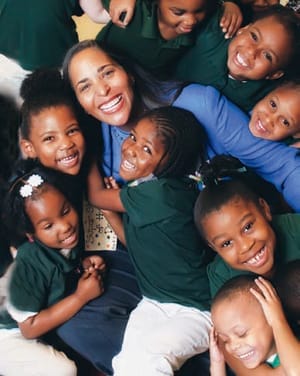Madelyn Adams knew she wanted to make a difference. She knew she wanted to work for a nonprofit.
She just wasn’t sure which nonprofit.
And once she started looking, she realized finding the right one wasn’t quite as easy as she anticipated.
It was early 2008 when Adams, WG’89, decided she would return to work after spending the previous two years at home, raising her two young boys. But while she had enjoyed prior professional success in entertainment (as a marketing manager with 20th Century Fox), sports (as Director of Media and Marketing for the Atlanta Committee for the Olympic Games), and media (as Vice President of Administration and Diversity at the Atlanta Journal-Constitution), Adams says the time spent with her boys changed her outlook on life—not to mention her career goals. “The time off allowed me to focus on what I wanted to do, and the impact I wanted to make,” she says.
For months, she explored opportunities in and around Atlanta, the city she had called home for more than a decade. She was offered three jobs, but turned down all of them.
They just weren’t the right fit, she says.
It was only when she found the East Lake Foundation—a nonprofit dedicated to improving the lives of people in Atlanta’s once dilapidated East Lake neighborhood—that she says she knew she had found her new home.
“My parents are Depression babies, and so they were asking me,‘What do you mean you’re turning jobs down?’” Adams jokes today. “But I wanted to use the skills I had acquired over the course of my business life, and when this opportunity at East Lake came along, it was literally the only one that I knew was right.”
The East Lake Foundation has been widely lauded as one of the great success stories in the nonprofit world. Its work has been profiled by CNBC, ABC and the New York Times, among many other news outlets, and its programs have been used as the model for similar programs in cities nationwide. As the foundation’s executive director since last August, Adams is charged, simply, with keeping the successes coming.
It’s a challenge she welcomes.
“I really wanted to do something where I was going to make a difference every single day,” she says. “And that’s what I feel like I’m doing now.”
The foundation was established by community leaders in 1995 to help bring new hope to residents of East Lake, which at the time was so impoverished, and so violent, that many in Atlanta referred to it as a “war zone.” A high-rise public housing project built atop what was once a golf course had become a haven for the drug trade, dragging down the entire community.
But in the years since, the foundation’s various programs in education, affordable housing and youth enrichment have made an enormous—and quantifiable—impact on the community.
In 1995, the employment rate in East Lake was 13.5 percent and only 4 percent of adult residents lived above the poverty line. A mere 5 percent of local fifth-graders met state standards for math and less than a third of local kids graduated from high school.
Today, violent crime is down 95 percent, and only 5 percent of adult residents are on welfare. At the East Lake Foundation’s partner school, the Charles R. Drew Charter School, 90 percent of students meet state standards in reading and 81 percent meet those standards in math.
Partly as a result, East Lake youth are finally beginning to see a college education as a reasonable goal. Nearly 90 percent of the students enrolled in the foundation’s Creating Responsible, Educated Working Teens (CREW ) program this year were accepted to post-secondary institutions. Among the program’s alumni is Jeffrey Johnson, W’13, a Drew graduate who earned a spot at his top college choice: Penn. A current freshman at Wharton, he plans to study economics.
“I can honestly say that without the foundation, I wouldn’t be at Wharton,” Johnson says. “It’s an awesome program.”
Adams says her goal at East Lake is to make sure more young people follow in Johnson’s footsteps.
To make that possible, she’s implemented strict new accountability standards—standards she learned in the for-profit world—to ensure that each of the foundation’s programs is actually achieving its stated goals. “Ultimately, nobody wants to throw their money away,” adds Adams. “I’m the one who is soliciting people for donations, so I have to be able to tell them, with confidence, where the money is going, what the outcome is going to be, and why it’s important that we meet it.
“When you’re running this kind of business, the most important thing, of course, is to raise money. But I think it’s equally important that whenever you’re spending your donors’ money you make sure you’re getting results. We are telling our donors, ‘Here are the outcomes we want to achieve.’ And we are asking ourselves, ‘What is most impactful? How do we achieve those outcomes?’ Working hard is great. But I really want results.”
The efforts are paying off.
In November, U.S. Secretary of Education Arne Duncan, speaking in New York to an audience of education policy makers, cited East Lake as a model of “the holistic approach to breaking the cycle of poverty.”
“It was a great day for us, to be acknowledged in front of such great company,” Adams says. “For us, it meant that our work has hit the radar screen.”

























